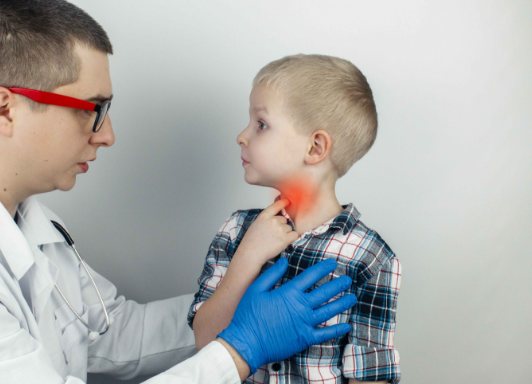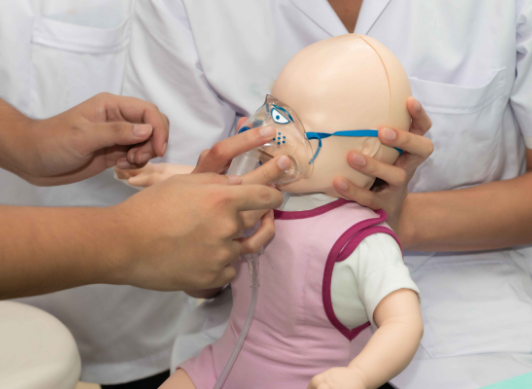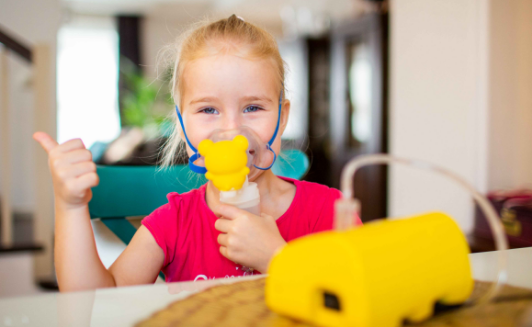Pediatric ENT Disorders
Airway Disorders
Pediatric ENTs will examine your child’s symptoms, medical history, and physical examination to diagnose the underlying problem. We will diagnose the underlying issue and discuss appropriate treatment.
- Tracheomalacia
- Laryngomalacia
- Tracheostomy
- Stridor
- Croup
- Chronic Cough
- Vocal Cord Paralysis
Tracheomalacia

Many different conditions can cause a child to have trouble breathing. Stridor is one of these conditions, and it is most commonly caused by the upper airway being inflamed. This inflammation can swell the airway, narrowing the passage for air to travel through and making it difficult for your child to breathe.
Stridor can also be caused by vocal cord dysfunction or laryngeal problems. If your child has stridor, a pediatric ENT specialist can perform an endoscopy to examine your child’s upper airway and vocal cords. This procedure is painless and can provide information about what is causing your child’s breathing issues. They will be able to determine if inflamed tissue or any other abnormalities are affecting your child’s ability to breathe.
Laryngomalacia
Laryngomalacia is an airway disorder that affects children. With Laryngomalacia, the larynx is abnormally soft and floppy, which leads to chronic or recurrent episodes of airway obstruction. A pediatric ENT will perform a physical exam on your child to identify symptoms and signs. The doctor will also take your medical history to rule out other disorders with similar symptoms. Some children with milder cases of Laryngomalacia might not need treatment at all; however, those who do require surgery called supraglottoplasty.
Your pediatric ENT will perform a surgical supraglottoplasty to tighten and stiffen your child’s larynx and airway. Surgery is only recommended in extreme cases of Laryngomalacia.

Many different conditions can cause a child to have trouble breathing. Stridor is one of these conditions, and it is most commonly caused by the upper airway being inflamed. This inflammation can swell the airway, narrowing the passage for air to travel through and making it difficult for your child to breathe.
Stridor can also be caused by vocal cord dysfunction or laryngeal problems. If your child has stridor, a pediatric ENT specialist can perform an endoscopy to examine your child’s upper airway and vocal cords. This procedure is painless and can provide information about what is causing your child’s breathing issues. They will be able to determine if inflamed tissue or any other abnormalities are affecting your child’s ability to breathe.
Tracheostomy
A tracheostomy is a surgical procedure that creates an opening in the neck to provide an alternate airway. The goal of this procedure is to allow air to go through the tracheostomy tube, bypassing the mouth and nose when breathing becomes difficult or impossible. A tracheostomy is performed when there are:
- An obstruction in your upper airway
- Difficulty swallowing
- Trouble breathing
- Mechanical ventilation is needed
The tracheostomy procedure is performed by a pediatric otolaryngologist (ENT doctor). This physician specializes in the surgery of both children and adults. The goal is to create an opening in your child’s windpipe, or trachea, to help with breathing.

Many different conditions can cause a child to have trouble breathing. Stridor is one of these conditions, and it is most commonly caused by the upper airway being inflamed. This inflammation can swell the airway, narrowing the passage for air to travel through and making it difficult for your child to breathe.
Stridor can also be caused by vocal cord dysfunction or laryngeal problems. If your child has stridor, a pediatric ENT specialist can perform an endoscopy to examine your child’s upper airway and vocal cords. This procedure is painless and can provide information about what is causing your child’s breathing issues. They will be able to determine if inflamed tissue or any other abnormalities are affecting your child’s ability to breathe.
Stridor
The word stridor is a medical term used to describe a high-pitched sound that occurs when there’s an obstruction in the throat or upper airway. Stridor can be either inspiratory (sounding like a snore) or expiratory (sounding like a croupy cough). The duration, loudness, and pitch of the stridor are all important factors to consider when evaluating what might be causing the obstruction.

Many different conditions can cause a child to have trouble breathing. Stridor is one of these conditions, and it is most commonly caused by the upper airway being inflamed. This inflammation can swell the airway, narrowing the passage for air to travel through and making it difficult for your child to breathe.
Stridor can also be caused by vocal cord dysfunction or laryngeal problems. If your child has stridor, a pediatric ENT specialist can perform an endoscopy to examine your child’s upper airway and vocal cords. This procedure is painless and can provide information about what is causing your child’s breathing issues. They will be able to determine if inflamed tissue or any other abnormalities are affecting your child’s ability to breathe.
Croup
Croup is a viral infection that causes swelling in the airway, leading to difficulty breathing. It usually starts in the neck and can lead to wheezing, barking, coughs, and stridor (a high-pitched sound caused by turbulent airflow). If you have croup, symptoms may go away within a week or two. However, they may also worsen. If this happens, talk with your doctor about medications such as dexamethasone or a bronchodilator such as epinephrine.

Many different conditions can cause a child to have trouble breathing. Stridor is one of these conditions, and it is most commonly caused by the upper airway being inflamed. This inflammation can swell the airway, narrowing the passage for air to travel through and making it difficult for your child to breathe.
Stridor can also be caused by vocal cord dysfunction or laryngeal problems. If your child has stridor, a pediatric ENT specialist can perform an endoscopy to examine your child’s upper airway and vocal cords. This procedure is painless and can provide information about what is causing your child’s breathing issues. They will be able to determine if inflamed tissue or any other abnormalities are affecting your child’s ability to breathe.
Chronic Cough
The majority of pediatric cases of chronic cough are caused by asthma, allergy, gastroesophageal reflux disease (GERD), or postnasal drip. Asthma is a chronic condition that can cause recurrent coughing and wheezing, shortness of breath, chest tightness, and difficulty breathing. Allergy sufferers may experience sneezing, runny nose, and itchy eyes and throat.

Stridor can be caused by vocal cord dysfunction or laryngeal problems. If your child has stridor, a pediatric ENT specialist can perform an endoscopy to examine your child’s upper airway and vocal cords. This procedure is painless and can provide information about what is causing your child’s breathing issues. They will be able to determine if inflamed tissue or any other abnormalities are affecting your child’s ability to breathe.
Vocal Cord Paralysis
- Difficulty talking and swallowing.
- Hoarseness.
- Chronic cough such as recurrent pneumonia
- Other respiratory problems.
Diagnosing vocal cord paralysis is not difficult for an ENT and can be done by a doctor during a routine examination. In order to be properly diagnosed, however, a doctor will want to rule out other causes of problems with speaking and swallowing. Medical imaging such as x-rays and CT scans are common for identifying additional problems in people who exhibit symptoms of vocal cord paralysis.


